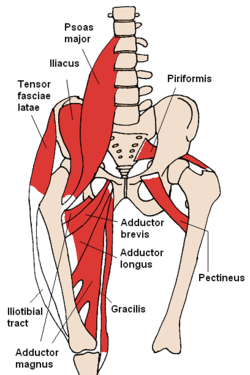Tame Your Hip Flexors with the Egoscue Tower
Oct 20, 2014
Your hip flexors are vitally important to aligned posture and efficient movement. Your two primary hip flexors are the Psoas and Iliacus muscles. As you can see in this Wikipedia illustration to the right, the Psoas muscle attaches to the spine, then passes in front of the pelvis and hip joint, transversing to its lower attachment point on the inside of the leg bone. The Iliacus attaches to the surface of the inner pelvic bone, then joins the Psoas in attaching to the inner thigh.
The Psoas is the only muscle to connect the upper and lower body, which is why it is so fundamental in posture and correct pelvic position. We also use our Psoas for movement extensively throughout our day. Every time you flex your hip--as in walking, cycling or going up stairs--your Psoas and Iliacus muscles are active. Sitting also uses the hip flexors. And the more you hunch forward while seated, the tighter these muscles have to hold on to keep you upright.
Tight hip flexors alter posture by increasing the lower lumbar curve, called anterior pelvic tilt. In my blog, 5 Exercises to Reduce Anterior Pelvic Tilt, I outline a short program of exercises that will help you to move the body towards the correct pelvic position. However, you cannot do these more traditional hip flexor stretches alone. They just can't create long-lasting changes by themselves.
Do you ever question why, when you stretch every day, your muscles are just as tight as the day before? This is because the stretches you are doing are only giving you temporary benefits. They are not creating enduring changes in the range of motion of your muscles. Instead of forcing your muscles to lengthen with short duration stretches, consider a more passive exercise that gradually lengthens the muscles and gives you permanent changes in muscle tension: the Egoscue® Tower.
I have spent many hours of my life in the Egoscue® Tower. And it has been worth it! Now, with my body in a better position, I am able to reduce my Tower time. It was a fundamental part of my healing and is my go-to when I have back pain. In addition to easing my anterior tilt, it also improved the position of my upper body. The following video animation shows the chain reaction effect created throughout the body while doing the Egoscue® Tower.
Although you probably don’t have an Egoscue® Tower, you can try this exercise today. Use a step stool for your extended leg or prop your foot on the couch or coffee table. Be sure to keep your foot pointing straight up and hence your hip in a neutral position. Relax and breathe in the position until your back is completely flattened into the ground before you move to a lower level. When you get off the floor, you’ll feel you’re standing in a better position, and previous back pain will be eased.
Please contact me with your questions about this exercise.
Stay connected with news and updates!
Join our mailing list to receive the latest news and updates from me.
Don't worry, your information will not be shared.
We hate SPAM. We will never sell your information, for any reason.


